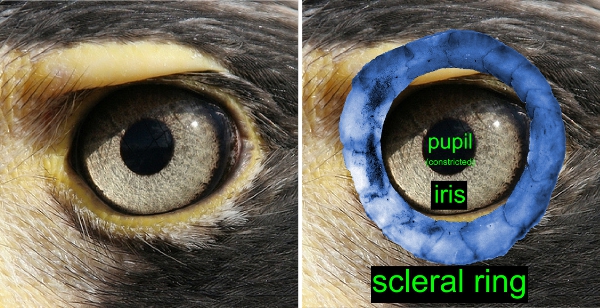Yet another non-teleost blog, but an interesting example of functional morphology and phylogenetic comparative methods. I’m cross-posting this on my own blog, too.
Nocturnal dinosaurs. Wait a second! Is that right? Nocturnal (= night-active) dinosaurs? Yes, indeed. Contrary to what was commonly believed, many dinosaurs were nocturnal. We have to change our perception of the dinosaur era.
All details about methods, results, and implications can be found in these two siblings papers in Science and Evolution (thanks to AAAS and Wiley for being so extremely helpful in coordinating this release!):
L. Schmitz, R. Motani, Nocturnality in dinosaurs inferred from scleral ring and orbit morphology. Science, published online 14 April 2011 (10.1126/science.1200043)
R. Motani, L. Schmitz, Phylogenetic versus functional signals in the evolution of form-function relationships in terrestrial vision. Evolution, published online 14 April 2011 (10.1111/j.1558-5646.2011.01271)
We make several important points in these papers: (i) Dinosaurs were not restricted to day-activity (diurnality) by any means, (ii) Activity patterns evolve following ecological characteristics (e.g., diet+body size, terrestrial or flying), (iii) Physics of the environment drive the evolution of shape, (iv) We have a great new tool for reconstructing ecology of extinct species.
So, why did everyone think that dinosaurs were diurnal in the first place? We think there are at least two (historical) reasons. First, several decades ago dinosaurs were portrayed as sluggish, “cold-blooded” animals. It seemed too unlikely that these animals were capable of being active at night, when ambient temperatures were cold compared to the day. Second, the idea of diurnal dinosaurs may have arisen because many (paleo)biologists were trying to explain why the majority of mammals is nocturnal – and the picture of dinosaurs occupying the diurnal niche, pushing the mammals into the dark just seemed to fit all too well.
Well, that story isn’t all that simple and straight-forward anymore. Dinosaurs were nocturnal, too. And we don’t even know if the earliest mammals were actually nocturnal (Kenneth Angielczyk at the Field Museum and I are working on this right now). So, the assumed split in activity pattern between mammals and dinosaurs is certainly rejected. However, we do see a different pattern emerging. It appears as if the evolution of activity patterns is driven by ecology.
We found striking similarities between the Mesozoic and today’s biosphere. Large herbivores, just like living ‘megaherbivores’, were active both day and night, probably because of foraging needs (they just had to eat most of the time…), except for the hottest hours of the day when there was risk of overheating. Small carnivores such as Velociraptor were nocturnal hunters. Flying species, including early birds and pterosaurs (like Scaphognathus above, with scleral ring highlighted in blue color) were mostly day-active (although some of the pterosaurs were actually nocturnal). These ecological patterns are also found among today’s living mammals, lizards, and birds.
So, how can we tell? Eye shape is the key. Nocturnal animals roam around in low light during the night, and their eyes show characteristics that relate to improved light sensitivity. Eye soft-tissues rarely if ever fossilize, but many vertebrates (e.g., teleost fish, lizards, and birds) have an extra bone element within their eyes, the so called scleral ring. Notably, neither mammals, crocodiles, nor snakes have scleral rings [for more details I would refer you to the work of Tamara Franz-Odendaal]. The scleral ring, however, is present in basal archosaurs, pterosaurs, and dinosaurs, which enables us to reconstruct eye shape in these fossils..
If you look at a bird eye (photos below) you will see the pupil opening defined by the iris. The scleral ring, situated within the sclera, the ‘leathery’ layer of the eye, surrounds the iris. The shape of the scleral ring and eye socket closely reflects eye shape, enabling us to distinguish nocturnal and diurnal dinosaurs.
For example, if you compare the scleral rings below, the nocturnal species on the right, a potoo, has a much larger ‘aperture’, or inner diameter than the diurnal hawk compared to eye socket size. Of course, the differences are often more subtle, so we use a Discriminant Analysis (DA) to retrieve a quantitative prediction. Prediction from a DA are rarely perfect, but overall the DA performs very well.
The relation between form and function of the eye is another convincing example how physics of the environment, that is light levels, drive the evolution of shape. However, it is not just physics that influences the evolution of shape. Shared ancestry is an important factor that may blur the form-function relation. Simply put, closely related species are expected to be more similar to each other than more distantly related species, so shape alone could potentially be misleading. With Ryosuke leading this part of the study, we solved this issue and developed a new method (implemented in ‘R’) that makes it possible to account for this phylogenetic bias. A step-by-step guide to this analysis is provided in the Supplementary Information of the paper in Science (www.sciencemag.org/cgi/content/full/science.1200043/DC1). We hope that this method will be helpful for other studies dealing with inferences of ecology from shape.




Recent Comments